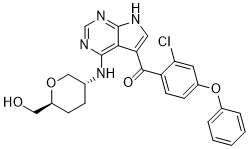This product is for research use only, not for human use. We do not sell to patients.

| Size | Price | Stock |
|---|---|---|
| 250mg | $1450 | Check With Us |
| 500mg | $2080 | Check With Us |
| 1g | $3120 | Check With Us |
Cat #: V4775 CAS #: 2095393-15-8 Purity ≥ 98%
Description: Nemtabrutinib (ARQ531; ARQ-531; MK-1026) is a novel, potent, orally bioavailable, and reversible / non-covalent BTK (Bruton's Tyrosine Kinase) inhibitor with potential antitumor activity. It inhibits WT-BTK and C481S-BTK with IC50s of 0.85 nM and 0.39 nM, respectively.
Publications Citing InvivoChem Products
Product Promise

- Physicochemical and Storage Information
- Protocol
- Related Biological Data
- Stock Solution Preparation
- Quality Control Documentation
| Molecular Weight (MW) | 478.933 |
|---|---|
| Molecular Formula | C25H23ClN4O4 |
| CAS No. | 2095393-15-8 |
| Storage | -20℃ for 3 years in powder formr |
| -80℃ for 2 years in solvent | |
| SMILES Code | O=C(C1=CC=C(OC2=CC=CC=C2)C=C1Cl)C3=CNC4=NC=NC(N[C@H]5CO[C@H](CO)CC5)=C43 |
| Synonyms | ARQ531; MK1026; ARQ-531; MK-1026; ARQ 531; |
| Protocol | In Vitro | ARQ 531 shows strong target inhibition in TMD8 cell line. The IC50 values are 0.85 nM and 0.39 nM for WT-BTK and C481S-BTK, respectively, in biochemical assay. Additionally, ARQ 531 also shows strong inhibition of TEK kinases with IC50s of 5.23 nM (BMX), 5.80 nM (TEC), 36.4 nM (TXK). The IC50s of ARQ 531 for SRC kinases are 3.86 nM (LCK), 4.22 nM (YES), 9.71 nM (BLK), 18.3 nM (HCK), 18.8 nM (LYNa), 25.9 nM (FGR), 32.2 nM (FYN), 48.0 nM (FRK) and for TRK kinases are 11.7 nM (TrkB), 13.1 nM (TrkA), 19.1 nM (TrkC). ARQ 531 inhibits proliferation of diverse types of cell lines (TMD8: GI50=0.13 μM, REC1: GI50=0.18 nM) and shows potency in cell lines that are addict to BCR, Src-family kinase and PI3K/AKT pathways. |
|---|---|---|
| In Vivo | ARQ 531 is efficacious in TMD-8 tumor xenograft model. ARQ 531 causes complete tumor regression after 14 days of treatment. ARQ 531 is also efficacious in collagen induced arthritis model. ARQ 531 demonstrates potent efficacy against arthritis in mouse model. In the BTK driven TMD8 xenograft mouse model, ARQ 531 demonstrates excellent anti-tumor activity with durable response. ARQ 531 demonstrates in vivo efficacy in a mouse collagen-induced arthritis (CIA) model. |
| Solvent volume to be added | Mass (the weight of a compound) | |||
|---|---|---|---|---|
| Mother liquor concentration | 1mg | 5mg | 10mg | 20mg |
| 1mM | 2.0880 mL | 10.4399 mL | 20.8797 mL | 41.7595 mL |
| 5mM | 0.4176 mL | 2.0880 mL | 4.1759 mL | 8.3519 mL |
| 10mM | 0.2088 mL | 1.0440 mL | 2.0880 mL | 4.1759 mL |
| 20mM | 0.1044 mL | 0.5220 mL | 1.0440 mL | 2.0880 mL |
This equation is commonly abbreviated as: C1 V1 = C2 V2
- (1) Please be sure that the solution is clear before the addition of next solvent. Dissolution methods like vortex, ultrasound or warming and heat may be used to aid dissolving.
- (2) Be sure to add the solvent(s) in order.




































